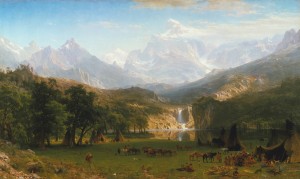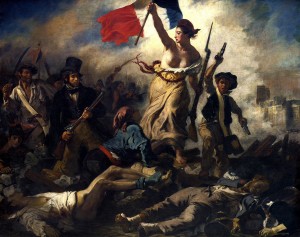Romanticism:
In terms of literature, the Romantic movement was active in the 18th and 19th centuries, serving as a rejection of neoclassical ideals. Romanticism is represented by its dismissal of reason and logic. Instead, romanticism shifted to valuing sensory, emotional, and imaginative experiences. German poet Friedrich Schlegel defined the movement as “literature depicting emotional matter in an imaginative form.” (Morner & Rausch, 1997). The movement sought to increase the values of imagination, nature, freedom, and individualism within society (Rahn, 2011).
The Rocky Mountains Lander’s Peak/by Albert Bierstadt
by Albert Bierstadt, used under ![]()
Revolutionary characteristics of romanticism:
When speaking in broad terms of romanticism and revolution, the movement exhibits revolutionary characteristics in its separation from neoclassicism.
Neoclassicism was the dominant theme of literature during the late 17th and 18th centuries. It sought to recapture the themes and values of classical greek and roman culture. This movement valued intelligence, wit, logic, order, and form over function. Corresponding with what the movement valued, neoclassicism looked down upon emotional expression, imagination, and freedom from rules (Morner & Rausch, 1997).
The romantic movement in literature is revolutionary for a handful of reasons, but most notably it was radical shift that was not a product of evolution. Romanticism is such a drastic change in value from neoclassicism that it is clearly revolutionary. “The general definition generally agreed upon is that Romanticism comprises the myriad escapes from neoclassicism” (Burgum, 1941). It flipped literature on its head, essentially reversing what the previous movement had done.
With the Industrial Revolution creating a large gap between the richest industrialists and the industrial workers, romanticism sought to express the feelings of the less fortunate. The themes present in literature could often be described as melancholy. Romantic writers idealized the past when things were simpler and perceived to be better (Rahn, 2011). The literature reflected the widespread feelings of discontent throughout Europe.
Liberty Leading the People
by Eugene Delacroix, used under ![]()
References:
Bierstadt, A. (1863). The Rocky Mountains Lander’s Peak. [Painting]. http://upload.wikimedia.org/wikipedia/commons/4/45/Albert_Bierstadt_-_The_Rocky_Mountains%2C_Lander%27s_Peak.jpg. Available under Public Domain.
Burgum, E. B. (1941). Romanticism. The Kenyon Review , 3 (4), 479-490.
Delacroix, E. (1830). Liberty Leading the People. [Painting]. http://upload.wikimedia.org/wikipedia/commons/a/a7/Eugène_Delacroix_-_La_liberté_guidant_le_peuple.jpg. Available under Public Domain.
Morner, K., & Rausch, R. (1997). NTC’s Dictionary of Literary Terms. Chicago. Retrieved from University of Houston.
Rahn, J. (2011). Romanticism. Retrieved April 4, 2014, from The Literature Network.


